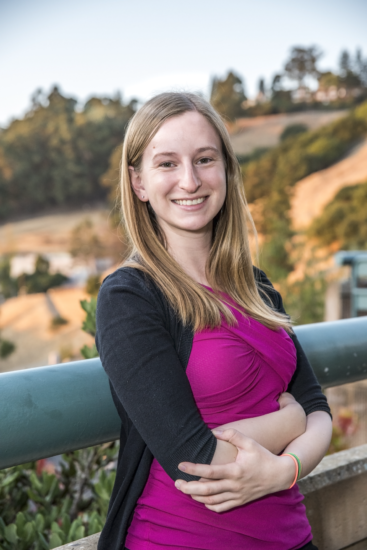 Natalie Larson, a current ALS doctoral fellow from UC Santa Barbara, won the first prize Neville Smith Student Poster Award at the 2017 ALS User Meeting. Larson’s winning poster—”In-situ x-ray computed tomography of defect evolution during polymer impregnation and pyrolysis processing of ceramic matrix composites”—featured the first two big in situ experiments she performed at Beamline 8.3.2.
Natalie Larson, a current ALS doctoral fellow from UC Santa Barbara, won the first prize Neville Smith Student Poster Award at the 2017 ALS User Meeting. Larson’s winning poster—”In-situ x-ray computed tomography of defect evolution during polymer impregnation and pyrolysis processing of ceramic matrix composites”—featured the first two big in situ experiments she performed at Beamline 8.3.2.
Larson has been an ALS user since 2014 and became a doctoral fellow in 2016. She’ll continue at the ALS for about another year through a National Science Foundation fellowship that will see her through the end of her PhD. The primary focus of her work is developing high-temperature ceramic matrix composites (CMCs) for more efficient jet engines. Larson works with Beamline Scientists Dula Parkinson and Alastair MacDowell and Project Scientist Harold Barnard on developing experiments for in situ x-ray computed tomography experiments to observe 3D real-time defect formation in CMCs.
Larson has written two papers based on this research, one of which—“In-situ 3D visualization of composite microstructure during polymer-to-ceramic conversion”—was recently accepted for publication. The other is currently in review. She has a few more in the works, and also recently contributed to a paper published with Berkeley Lab’s Center for Advanced Mathematics for Energy Research Applications (CAMERA), a group she works with closely in her research projects.
“That paper was really exciting because I think it marks a big step forward for the collaboration between the ALS and CAMERA,” says Larson.
Collaboration has been one of the highlights of Larson’s time here at the ALS. Between the beamline scientists and interns at Beamline 8.3.2, the people involved with CAMERA, and ALS users, she gets a perspective that’s hard to attain elsewhere. “It’s something you can only get at a user facility—the ability to meet people from all around the world who are coming here to do a diverse array of science, working on different problems that I hadn’t even heard of before I came here,” she says.
Larson is looking forward to a new high-temperature furnace that’s under development at 8.3.2, which would enable users to image an entire specimen while it’s being heated. “It would be applicable to a lot of users working with materials that need to be imaged while heated at a variety of temperatures,” she says.
Neville Smith was the Scientific Director for the ALS from 1994 until his death in 2006. He was known not only for his scientific expertise, particularly in photoemission spectroscopy, but also for his wicked wit. As a great supporter of young scientists, his contribution is acknowledged by the naming of the Student Poster Award in his honor, beginning in 2014.